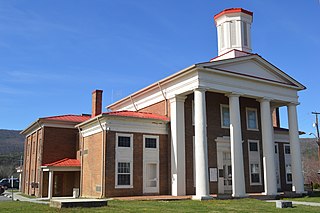
New Castle Historic District is a national historic district located at New Castle in Craig County, Virginia, United States. It encompasses 111 contributing buildings, 2 contributing sites, and 1 contributing object in the central business district and surrounding residential areas of New Castle. The focal point of the district is the Craig County Courthouse. It was built about 1850, and is a temple-form structure with shallow gable roof, a two-story tetrastyle Greek Doric order portico and wooden hexagonal cupola. Associated with the courthouse is the sheriff's house and old jail. Other notable buildings include the Central Hotel, First National Bank Building, Layman Insurance Agency building, Givens-McCartney House (1837), Caldwell-Berger-Lamb House, Bank of New Castle, Farmers and Merchants (F&M) Bank of Craig County (1917–1920), Wagener Brothers Store, Bill Caldwell General Store, George W. Craft, New Castle Methodist Episcopal Church, and Masonic Temple (1940).

Bristersburg Historic District is a national historic district located at Bristersburg, Fauquier County, Virginia. It encompasses 19 contributing buildings, 1 contributing site, 1 contributing structure, and 1 contributing object in the rural crossroads of Bristersburg. They include three dwellings, a church, a school, and three stores. Notable buildings include the Tulloss Brothers Store, Zoar Baptist Church (1852), Bristone House, Compton’s Store, Eskridge House, The Bristersburg School (1910) and Payne's Store.
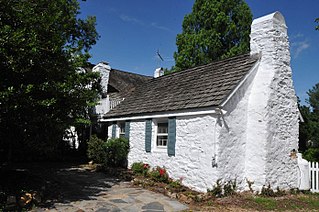
Rectortown Historic District is a national historic district located at Rectortown, Fauquier County, Virginia. It encompasses 76 contributing buildings, 3 contributing sites, and 2 contributing structures in the rural village of Rectortown. The district includes dwellings dating back to the 18th century, churches, a school, an Odd Fellows hall, a post office, multiple commercial buildings, and several cemeteries that illustrate the town's growth and development. Notable buildings include the Maidstone Ordinary, the Rector-Slack Log House, the Ashby House, the Georg Mann House, The Brick Store House, Rector's Warehouse and Station, Denham, Maidstone, Rectortown United Methodist Church (1894), the Jackson-Grant House (1924), Slack's Store (1890), and the Mt. Olive Odd Fellows Lodge (1935).
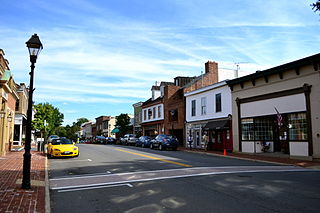
Warrenton Historic District is a national historic district located at Warrenton, Fauquier County, Virginia. It encompasses 288 contributing buildings in the central business district and surrounding residential areas of the county seat of Warrenton. Notable buildings include the old Fauquier County courthouse (1890), Fauquier County Administration Building (1928), the former Fauquier County Public Library (1923), Fauquier National Bank (1925), "Paradise" (1758), the Thomas L. Moore House (1816), the James Caldwell House (1831), the John Quincy Marr House (1830), the Marshall Building, the California Building, old Town Hall (1854), Warrenton Presbyterian Church (1855), Ullman's Store, and "Mecca" (1859). Also located on the district are the separately listed Brentmoor and Old Fauquier County Jail.

Town of Halifax Court House Historic District is a national historic district located at Halifax, Halifax County, Virginia. The district includes 172 contributing buildings, 1 contributing site, 13 contributing structures, and 1 contributing object in the Town of Halifax. Resources include government, commercial, residential, religious, educational and industrial buildings that date from the early-19th Century to the mid-20th century. Notable buildings include the Rice House, Edmunds/Lewis Office (1869), People's Bank, Beth Car Baptist Church (1892), Christ Episcopal Church, Saint Luke's Christian Methodist Episcopal Church, Dr. Carter House, County Office Building (1915), Town of Halifax Swimming Pool (1930s), Municipal Building/ Fire Station (1950), Halifax Roller Mills (1915), Halifax Planing Mill, Halifax Department Store (1949), and Randolph Theater. Also located in the district is the separately listed Halifax County Courthouse.

Village of Morattico Historic District is a national historic district located at Morattico, Lancaster County, Virginia. The district encompasses 69 contributing buildings, 1 contributing site, and 3 contributing structures in the village of Morattico. The district includes residential, commercial, and institutional buildings in a community whose economy was based on water-borne transportation, seafood extraction, and seafood processing. The village developed after 1890. Notable buildings include the Morattico General Store, Dr. Lewis' Office, Morattico Post Office (1949), Jackson Seafood (1950), Shelton Crab House, and Emmanuel United Methodist Church (1898).

Round Hill Historic District is a national historic district located at Round Hill, Loudoun County, Virginia. It encompasses 204 contributing buildings, 1 contributing site, and 1 contributing structure in the town of Round Hill. It includes a variety of residential, commercial, and institutional buildings, with the majority built between 1880 and 1920. Notable buildings include the Gregg-Parks-Potts House, Guilford Gregg Store, Sagamore Hall, James Copeland House (1886), Hibbs House, African Methodist Church (1892), Mount Zion Baptist Church, Round Hill Baptist Church, Round Hill United Methodist Church, Castle Hall, Ford's Store, Round Hill Grocery, and the former Round Hill Railroad Depot (1902).
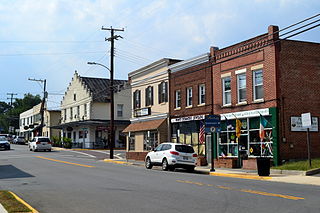
Purcellville Historic District is a national historic district located at Purcellville, Loudoun County, Virginia. It encompasses 490 contributing buildings and 8 contributing structures in the central business district and surrounding residential areas in the town of Purcellville. The buildings represents a range of architectural styles popular during the 19th and 20th centuries in rural Virginia. Notable buildings include the former Purcellville School, Purcell House and Store, Bethany United Methodist Church, St. Francis de Sales Catholic Church, Purcellville National Bank (1915), Town Hall (1908), and Asa Moore Janney House. The Bush Meeting Tabernacle is located in the district and separately listed.

Mineral Historic District is a national historic district located at Mineral, Louisa County, Virginia. It encompasses 222 contributing buildings, 3 contributing sites, and 6 contributing structures in the town of Mineral. It includes a variety of residential, commercial, and institutional buildings built after the town was platted in 1890. Notable buildings include the Gibson House (1915), Turner House, Dr. H. J. Judd House (1906), Odd Fellows Hall (1894), former D.E. Bumpass Department Store, former Mineral Drug Store, Bank of Louisa, C&O railroad depot (1880s), Mineral Crystal Ice Plant, Louisa County Power & Light Plant, Standard Oil Company building (1907), Episcopal Church of Incarnation (1902-1903), Mineral Baptist Church (1906), and the former Mineral School (1927).

The Boydton Historic District is a national historic district located at Boydton, Mecklenburg County, Virginia. It encompasses 199 contributing buildings, 6 contributing sites, 6 contributing structure, and 2 contributing objects in the central business district and surrounding residential areas of the town of Boydton. Notable buildings include the municipal building (1905), the old jail (1870), the Beales, Bedinger, and Gregory, Inc. car dealership building (1918), Washington Tavern, Williams and Goode Bank (1908), Boydton Department Store (1935), Mecklenburg County Building Department (1949), Southside Regional Library (1939), Presbyterian Meeting House (1819), Saint James Episcopal Church (1840-1841), Boydton Baptist Church, Trinity Episcopal Church (1890s), "Cedar Crest" (1825), and "On the Hill" (1920), which was separately listed in 2015. Also located in the district and separately listed are the Boyd's Tavern and Mecklenburg County Courthouse.

Riner Historic District is a national historic district located at Riner, Montgomery County, Virginia. The district encompasses 23 contributing buildings and 1 contributing structure in the village of Riner. It includes a variety of vernacular residential, commercial, and institutional buildings dating from the 1850s to 1920s. Notable buildings include the Methodist Episcopal Church (1908), Bank of Riner (1912–1913), Jonathan E. Hall House / Store, Kinsey-Lawrence House (1908–1909), Dr. Stone Farm, Surface Mill, Auburn United Methodist Church (1885), and Sam Barnett Store.

Gordonsville Historic District is a national historic district located at Gordonsville, Orange County, Virginia. It encompasses 85 contributing buildings and 2 contributing structures in the town of Gordonsville. They include 19th- and early 20th-century residential, commercial and institutional buildings in a variety of popular architectural styles including Colonial Revival, Greek Revival, and Georgian Revival styles. Notable buildings include the E.J. Faulconer House, Faulconer-Schlosser House (1868), Linney-Barbour Building (1870), Swan-Payne House (1901), Magnolia House, Gordonsville Christian Church, Gordonsville Presbyterian Church (1855), Gordonsville Methodist Church (1873), St. Mark's Catholic, Christ Episcopal Church, Grammar School (1877-1878), Memorial Hall, Sneed's Store, Allman Building, Gordonsville Motor Car Company Building, The Old Oaken Bucket, and the Blakey Building (1916). Located in the district is the separately listed Exchange Hotel.

Glasgow Historic District is a national historic district located at Glasgow, Rockbridge County, Virginia. The district encompasses 43 contributing buildings, 3 contributing sites, and 1 contributing structure in the central business district of the town of Glasgow. It includes a variety of residential, commercial, and institutional buildings dating from the 1820s to 1920s, with most structures from the 1890s. Notable buildings include the Rebecca Salling House, First Baptist Church, the former Glasgow Baptist Church, St. John's Episcopal Church, Blue Ridge Building, and Glasgow Masonic Temple (1891-1892).
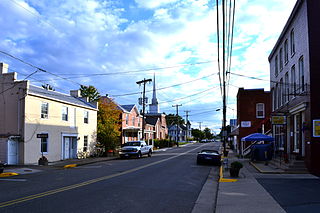
Dayton Historic District is a national historic district located at Dayton, Rockingham County, Virginia, USA. The district encompasses 154 contributing buildings and one contributing site in the central business district and surrounding residential areas of the town of Dayton. It includes a variety of residential, commercial, and institutional buildings most of which date from the late-19th century and early-20th century. Notable buildings include the Alberta Coffman House, Layman House, the Samuel Shrum House, the Thomas House, W.J. Franklin House, Bank of Dayton (1911), the Ruebush-Kieffer Printing Company, Dayton Drug Company, Howe Memorial Hall, the Administration Building (1910), the Kieffer Alumni Gymnasium (1930), Carpenter Store (1888), Specialty Harness Company, Ruebush-Kieffer Company, and the Methodist, Presbyterian, and United Brethren churches.

Marion Historic District is a national historic district located at Marion, Smyth County, Virginia. The district includes 361 contributing buildings, 2 contributing sites, and 1 contributing object in the central business district and surrounding residential areas of Marion. It includes a variety of residential, commercial, institutional, industrial, and governmental buildings primarily dating from the mid-19th to mid-20th centuries. Notable buildings include the Sheffey Loom House, Odd Fellows Lodge, Look & Lincoln Wagon Factory warehouse, the Beaux-Arts style Marion County Courthouse (1905), Mt. Pleasant Methodist Church, Courtview Building (1890s), Marion High School (1907-1908), Marion Junior College (1912), the Overall Factory, Weiler Building, Bank of Marion (1922), Royal Oak Presbyterian Church (1923), Marion Municipal Building (1935), Marion Post Office (1936), and a Lustron house (1948). Also located in the district are the separately listed Hotel Lincoln, Lincoln Theatre, Marion Male Academy, and Norfolk & Western Railway Depot.

Saltville Historic District is a national historic district located at Saltville, Smyth County, Virginia. The district includes 104 contributing buildings and 3 contributing sites in the central business district and surrounding residential areas of Saltville. It includes a variety of residential and commercial buildings primarily dating from the late-19th to mid-20th centuries. Notable buildings and sites include Well Fields, Saltville Golf Course, Office Building (1850), Mathieson Alkali Office Building (1894), company store (1895), First National Bank of Saltville, St. Paul's Episcopal Church (1896), Gothic Revival style Madam Russell Memorial United Methodist Church, Duplex House (1894), Saltville Post Office (1931), Piggly-Wiggly Store, Saltville Savings Bank (1920), and Saltville Town Hall (1949).
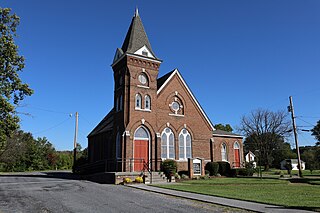
Riverton Historic District is a national historic district located at Front Royal, Warren County, Virginia. The district encompasses 66 contributing buildings and one contributing site in the town of Front Royal. It is a primarily residential district with buildings dating from the mid-19th century and including a diverse collection of building types and architectural styles. Notable buildings include Lackawanna (1869), the Old Duncan Hotel, the Riverton United Methodist Church (1883-1890), Dellbrook, the Carson Lime Company worker's houses, and the Old Riverton Post Office and Grocery. Located in the district and separately listed is Riverside.

Rugby Road–University Corner Historic District is a national historic district located at Charlottesville, Virginia. The district encompasses 173 contributing buildings in the city of Charlottesville. It includes a variety of commercial, residential, and institutional structures mirroring the University of Virginia's development between the 1890s and the Great Depression. It includes properties on Carr's Hill. Notable buildings include the Chancellor Building (1920), the Minor Court Building, Mincer's Shop Building 1920s), the Stevens-Shepherd Building, Buckingham Palace, St. Paul's Episcopal Church (1926–27), Madison Hall (1905), fraternity houses dating from 1902 to 1928, Fayerweather Hall (1893), the Bayly Museum (1934), Faculty Apartments building, Watts-Hillel House (1913-1914), and Hotopp-Watson House (1900). Also located in the district are the separately listed Anderson Brothers Building, Preston Court Apartments, and Wynhurst.

The Waverly Downtown Historic District is a national historic district located at Waverly, Sussex County, Virginia. The district encompasses 48 contributing buildings, 1 contributing site, and 2 contributing structures in the central business district of Waverly. The buildings represent a variety of popular architectural styles including Folk Victorian and Italianate. They include residential, commercial, governmental, and institutional buildings dating from the mid-19th to mid-20th centuries. Notable buildings include the Waverly Municipal Hall, Atlantic and Danville Railroad Station, Masonic Lodge/Town Hall, Boarding House, Moss Hardware Building, Fleetwood Building (1904), Warner Grammer Store, Wilcox Building, former Waverly Post Office/ Palace Cigar and Pool Room (1961), and Waverly Town Shops and Water Tower (1932).
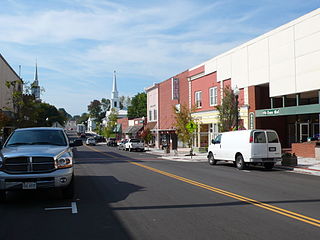
Christiansburg Downtown Historic District is a national historic district located at Christiansburg, Montgomery County, Virginia. The district encompasses 32 contributing buildings, 1 contributing site, and 2 contributing objects in the central business district of Christiansburg. The district includes a variety of one-, two-, or three-story commercial or office buildings built primarily from the 1915-1950 period. The courthouse square is the cultural and historic center of the district. Notable buildings include the Taylor Office Building, Bank of Christiansburg (1963), Dr. George Anderson House, Zirkle Building (1910), Cromer Furniture Building, Presbyterian Manse (1876), Barnes-Surface Motor Co., Virginia Inn Hotel, and Leggett's Department Store (1958). The contributing objects are the Confederate Memorial (1883) and War Memorial (1953). Located in the district and separately listed are Christiansburg Presbyterian Church, U.S. Post Office, and Phlegar Building.

























